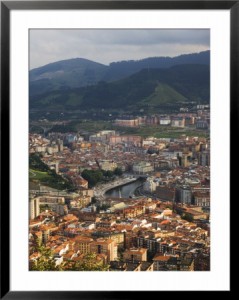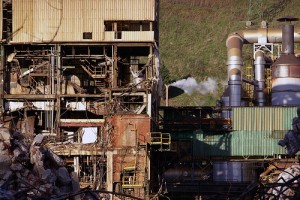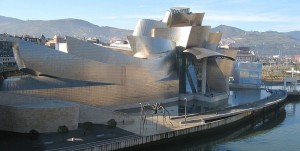Can a museum save a city? yes.
Well in light of my weekend workshop on the Guggenheim Museum in Bilbao it can. Dr. Joseba Zuliaika has written several books and articles on the museum. So here is how you make this work:
Ingredients:
– 2 egotistical playboys (Who are very good at their jobs.)
-1 depressed city that is obsessed with urban renewal (With a lot of money)
-1 museum that wants to become an international franchise
-1 extremely well rehearsed cover story to smooth out the museum politics
Directions:
Blend together for a couple of years and hope the price of titanium goes below the price of stainless steel
Bake using incredible (for the time) computer technology for wanted architectural design
Results:
Tourist driven resurrected city complete with river/museum view downtown condos.
*Here is the story as argued by Zulaika, who has had personal interviews with the people involved in the project. Thomas Kerns came to be director of the Guggenheim Museum in New York. The museum was in terrible debt when Kerns came on to the scene. His solution to the problem was to make the Guggenheim an international franchise to take the museum out of debt and double the art display (the current shown art is only 2% of the collection owned by the Guggenheim doubling that to 4% for any museum is quite a feat) . Enter Kerns playboy attitude. In Zulaika’s book he quotes Kerns, “Seduction: that’s my business. I am a professional seducteur. I don’t’ earn money but I raise it, and I do it by seduction. I make people give me gifts of twenty million dollars. Seduction consists in getting people to want what you want without having to ask for it. It is a transfer of desire. I am in a way the greatest prostitute in the world.”[i] Kerns traveled Europe searching for place to put his new museum. In the cover up story he did all of this without the help of the architect Frank Gehry. Gerhry came only after a competition between him and two other architects for the design of the Guggenheim Bilbao Museum (so the cover story goes). Bilbao came to Kerns. Bilbao was city that constantly attempted to remake itself. For over century plans had been in drawn up for new projects. Several that never came to life. It was beautiful well structured 18th city. The city’s ambition was to change with the times. It took hold of the industry age and become a factory city. A river runs through the city one side 18th century style and the other a black chimney of smoke form the factory. In the 1980’s the factories shut down and the down suffered from 25% unemployment. With nothing to lose they were willing to gamble the all their money for the museum. The government promised the money to Kerns and the building project began. Ego’s aside both men are extremely good at what they do. The beauty of the titanium plated Guggenheim Bilbao museum is creative, controversial, and has a shock value that paid off of the city. It has now become a well know stop on European trips. It has house art exhibits of Armani and motorcycles. Zulaika argued that Guggenheim Museum saved the town of Bilbao form economic ruin.


Now what does any of this have to with historical preservation? It is an example of preservation, although the museum is art museum it illustrated for example from Historical Preservation. The first painfully obvious connection was the quote on page 7 “Therefore, when we build, let us thinks for ever. Let it not be for present delight, not for present use alone: let it be such a work as out descendants will thank us…” This quote is the very intention of the design of the Guggenheim Museum in Bilbao. It also encompasses the matching, compatibility, and contrast. It does not disrupt the 18th century city that come down on one side of the river, it replaced the old factories that stood across from the historic part of the city and yet did not complexly destroy the “ugly” history industrial history that still stands in “ruins” beside the museum. The museum, also, stands in sharp contrast to the old city and the new. It blends all three opportunities for preservation in one city. We argued in class that a poor economy generates revenue for museums. The book illustrated the boost for preservation pushed by the depression and Bilbao launched multi-museum that paid for itself within five years of it’s opening.
Guggenheim Museum aside, I am very critical of historical preservation. I do not think a building should be “preserved” empty space because the first someone once resided there. If a building is to be persevered it should be used to benefit the people of the present and the future. Whether for education on its historical importance or new economic needs it has to an occupied space. I am annoyed by the “historical sites” the litter the highways of the west that could be potential stopping a useful freeway. I love the idea of historical city ordinances as long as they do remain within a community’s needs and wants. I am a complete sucker for the “edutainment” of Colonial Williamsburg, but I am also aware that it is “cute” picturesque showing of history.
[i] Joseba Zulaika, Guggenheim Bilbao Museoa: Museums, Architecture, and City Renewal, (Reno, Nevada: Center for Basque Studies, 2003), 93.
*Guggenheim argument is taken from notes on the Guggenhiem Museum workshop and according to Dr. Zulaika can be found in his book Cronica de una seduccion: el Museo Guggenheim-Bilbao (Nerea, Madrid, 1997)
Geggenhiem Museum picture from thebesttraveldesinations.com
Bilbao 18th century cityscape picture from art.com
Bilbao ruins picture under creative commons found on flickr under by Red Castle
